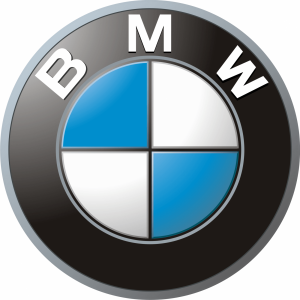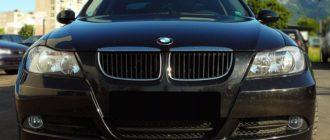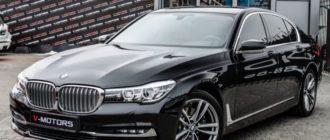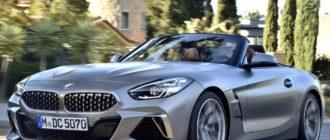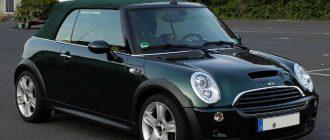The BMW 6 E63 replaced the E24 model. By the way, the main competitor — Mercedes — has a model with the same name. The six series BMW coupe was introduced to the public in 2003. A convertible version, named E64, debuted a year later. The car underwent an update in 2007, with the next modernization happening in 2011.
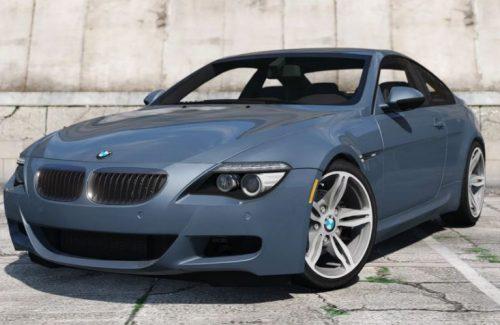
Exterior of BMW 6 E63
Car enthusiasts and experienced experts appreciated the appearance of the vehicle. However, some were not fond of the front end, finding it somewhat gloomy. The long hood with subtle relief, beautiful original headlamps, narrow with lenses inside. Between the headlights, there is a radiator grille. Everything is beautiful, elegant, and expensive — it is evident that not only money but also souls were invested in the car.
The bumper cannot be called massive, but due to its sculpted forms, it looks quite aggressive. On the sides, there are round fog lights, and at the bottom, there are air intakes designed for ventilating the front wheel brake mechanisms. The well-thought-out body kit of the BMW E63 improves aerodynamic properties.
Looking at the body from the side, attention is drawn to the wheel arches — connected at the bottom with stamping and slightly flared. Below the door handle, you can observe a stamped line, which also catches the eye.
The trunk lid of the BMW 6 E63 is also sculpted, long, with a stop signal repeater. The rear lights are triangular, with light reflectors in the bumper. Just below are the exhaust pipes. Depending on the configuration, there can be 2 or 4 of them.
Original alloy wheels R18 or R19 are installed on coupe bodies. The overall dimensions of the car do not depend on the body type:
- length 4820 mm;
- width 1855 mm;
- height 1373 mm;
- ground clearance 140 mm.
The curb weight is 1650 kg, and the total weight is 1995 kg. Now, let's delve into a more detailed description of each body element.
Hood
The distinctive appearance is achieved by the relief on the hood. This adds aggression to the exterior. But there is a practical aspect — beneath these reliefs are stiffness ribs that absorb impact force in the event of a frontal collision.
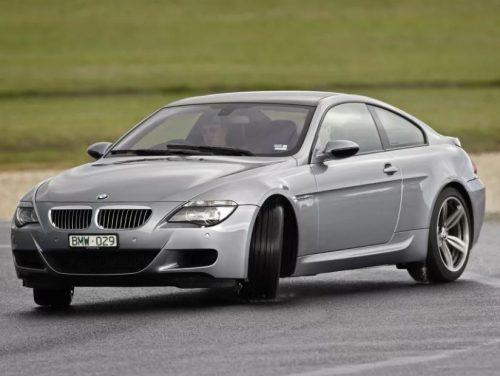
Additionally, the hood is quite long — this is also done for safety reasons, to increase the distance from the engine compartment to the driver.
Brake System Cooling
At the bottom of the bumper, there are air intakes designed to direct airflow to the brake discs. This also contributes to safety and brake system longevity. When driving such a car, the brake system operates in extreme modes, requiring cooling. Thanks to the presence of air intakes, the brake pads and discs do not overheat.
Textured Side
There is also a textured line on the side, designed to improve the car's aerodynamic qualities. The side lines are capable of generating maximum downforce to reduce the coefficient of drag. This enhances the dynamic characteristics and handling. Even at high speeds, cornering does not induce roll or skidding.
Interior of BMW 6 E63
As with most BMW models, harmony and functionality reign in the cabin. Only high-quality finishing materials are used. The assembly is done at the highest level. Maintaining optimal cabin air temperature is ensured by climate control. All passengers and the driver are protected by an active safety system.
The first row of seats — comfortable leather-upholstered chairs with electric adjustments and heating. The second row — a large comfortable sofa. Surprisingly, there is ample space both in the front and back, despite being a coupe body. Usually, passengers in rear seats of such cars often experience discomfort, but the BMW 6 E63 is an exception to this rule.
The three-spoke steering wheel has a diameter of 379 mm, very convenient and functional, with height and reach adjustment. There are 6 buttons on the steering wheel, allowing control of the multimedia system and mobile phone. It is worth noting that two buttons can be programmed for other functions.
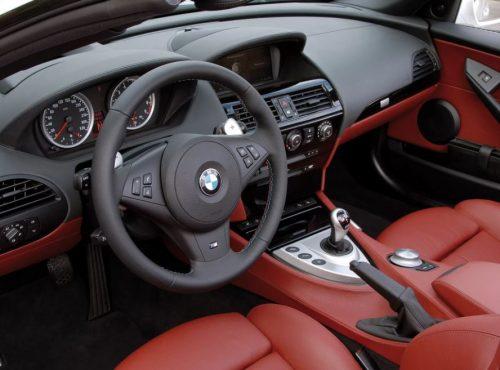
For convenience, there are paddles that allow gear shifting without taking hands off the steering wheel. Behind the wheel, there is an instrument panel consisting of two indicators — a speedometer and a tachometer, with a trip computer located between them. On the center console are the navigation and multimedia systems, slightly below are the deflectors and the hazard button.
Moving on to the climate control units. There are a total of three rotary knobs and 6 buttons to set the operating mode. Below the climate unit are slots for CDs and a compartment for storing various small items.
Between the seats is a tunnel, which also has a small compartment, a gear shift lever, stability control system switch button. To the left of the gear lever is the handbrake, to the right are the buttons for controlling the multimedia system, further right — the armrest.
The trunk in coupe bodies is usually of small volume, but the BMW 6 E63 surpasses all its competitors in this regard. 450 liters of usable space — more than enough for a shopping trip or a barbecue out of town.
Read more: BMW M6 F06 Review
Equipment Features of BMW 6 E63
In coupe body cars, the front optics are adaptive. Sensors read data on the steering wheel angle, speed, and send it to the control unit. Then the optical system creates a light beam with the optimal angle.
At the rear of the car, the brake lights are two-section. The brake indicators send a signal to the control unit and activate the stop lights. If the braking is mild, one section lights up. If it's strong — both light up.
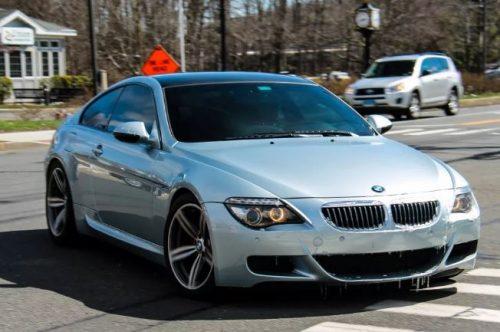
There is the option to install a panoramic electric sunroof on the roof. Coupe body cars can be equipped with different wheel rims:
- base version — alloy spoked R18;
- star-shaped R17;
- double-spoke R18;
- R19.
All wheels are fitted with Run-flat tires, manufactured using innovative technology. Their uniqueness lies in maintaining their shape even in the event of a puncture due to the reinforced chassis. Damaging such tires is quite challenging. There are also other highly effective solutions implemented in the models:
- Regenerative braking energy.
- Fuel injection system.
- High Precision Injection technology.
- Gear engaged indication on manual transmission.
- Improved transmission, ensuring reduced fuel consumption and emissions without compromising the car's performance.
Technical Specifications of BMW 6 E63
Let's start with the engines. Over time, this model had only 1 diesel engine and 4 petrol engines. Three of them were six-cylinder, and two were eight-cylinder.
The N52B30 engine was installed on the BMW 630i E63 until 2007. It was then replaced by the N53B30. Both engines have the same displacement — 3 liters. However, the first had a power of 258 hp, while the latter had 272 hp. With the N53B30 engine, the car accelerates to the first hundred in 6.4 seconds. The top speed is 250 km/h, city fuel consumption is around 13 liters, and on the highway — only 7 liters.
One eight-cylinder engine has a power of 333 hp. It was installed on the BMW 645 Ci E63. The 4.4-liter engine features Double-VANOS and Valvetronic systems, ensuring maximum performance and optimal dynamics.
The second engine, N62B48, also V8, has higher power — 367 hp. The engine displacement is 4.8 liters. It was installed on the 650i E63 modification. It allows the car to accelerate to the first hundred in just 5 seconds. The maximum speed is 250 km/h, and the fuel consumption in the city is 17 liters, on the highway — 9 liters.
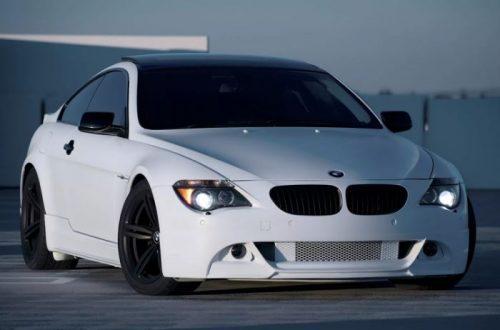
The three-liter diesel engine M57TU2D30TOP was installed on the 635d modification. The power of 286 hp is achieved due to the Common Rail system and a two-stage turbocharger. Acceleration to the first hundred takes 6.3 seconds, the top speed is 250 km/h. The fuel consumption is not very high — only 5.5 liters on the highway and 9 liters in the city.
All engines were paired with a six-speed manual transmission and a six-speed automatic. From 2006 to 2008, cars were equipped with SMG automatic transmissions. It was with them that the steering wheel paddles appeared in the cabin.
Safety and Electronics
Various systems were introduced to enhance the car's safety. These include ABS (anti-lock braking system), DBC/DSC for dynamic brake control and stability, respectively. DSC is activated only in critical situations and allows braking control for each wheel.
Stability is ensured by the Dynamic active suspension system. Body roll is reduced thanks to stability stabilizers on both axles. Comfortable driving is provided by the active steering control system. Depending on the vehicle's speed, the steering wheel angle changes.
In other words, at moderate speeds, the steering is direct. In parking mode, for example, to turn the wheel from one extreme point to another, two complete turns are required. According to owner reviews, such systems greatly assist in driving.
Differences in Facelift Models
In 2007, the BMW 6 E63 underwent slight changes. New bumpers, wheel rims, and changes to the trunk lid were installed. The configuration of the front and rear optics also changed.
Inside, a new multimedia system, seats, and gear shifter were installed. All ergonomic flaws found in the pre-facelift version were addressed.
The engines also underwent changes — the larger 4.4-liter engine was replaced by only three-liter engines. However, their power was increased to 272 hp. The 286 hp diesel engine began to be installed in models from 2007 onwards.
